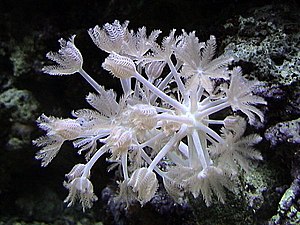Xeniidae
| Xeniidae | ||||||||||
|---|---|---|---|---|---|---|---|---|---|---|

Xenia sp. |
||||||||||
| Systematics | ||||||||||
|
||||||||||
| Scientific name | ||||||||||
| Xeniidae | ||||||||||
| Ehrenberg , 1828 |

The soft corals of the Xeniidae family live in shallow water throughout the tropical Indo-Pacific , often on dead hard corals . As with all soft corals, there are animal colonies that consist of many individual polyps . In contrast to the Alcyoniidae, they have very small sclerites . Their growth form is very diverse. Many species grow mushroom-shaped, others grow creeping. In many species there are, in addition to the large polyps, which are responsible for nutrition and reproduction, also small, barely visible ones, which are exclusively responsible for the exchange of water between the body and the surrounding water. The first type of polyp is called an autozooid, the second siphonozooid.
They live in a symbiotic relationship with small algae ( zooxanthellae ) that provide them with nutrients. You are therefore dependent on bright locations. Some genera, such as Xenia, are exclusively dependent on this supply of nutrients, as their gastric space has grown over and they can no longer take in food.
The Xeniidae can also be cultivated in saltwater aquariums . Species in which the polyps perform pulsating movements are especially popular. They grow extremely quickly and can overgrow large parts of the decoration.
Genera
- Asterospicularia
- Cespitularia
- Efflatounaria Gohar, 1934
- Fungulus
- Heteroxenia Kölliker, 1874
- Ovabunda Alderslade, 2001
- Sansibia
- Sarcothelia
- Sympodium
- Xenia Lamarck, 1816
The genus Anthelia , which for a long time belonged to the Xeniidae, does not belong to this family, according to a phylogenetic study, but is at the base of an unnamed clade whose crown group is the Nephtheidae . The genera Lemnalia and Paralemnalia , which previously belonged to the Nephtheidae, belong to the Xeniidae family.
literature
- K. Fabricius & P. Alderslade: Soft Corals and Sea Fans . 2001, Australian Institute of Marine Science. ISBN 0-642-32210-4
Individual evidence
- ↑ CS McFadden, SC France, JA Sánchez, P. Alderslade: A molecular phylogenetic analysis of the Octocorallia (Cnidaria: Anthozoa) based on mitochondrial protein-coding sequences , doi : 10.1016 / j.ympev.2006.06.010
- ^ Interview with Catherine McFadden. In KORALLE, marine aquarium specialist magazine, No. 49 February / March 2008, Natur und Tier Verlag Münster, ISSN 1439-779X